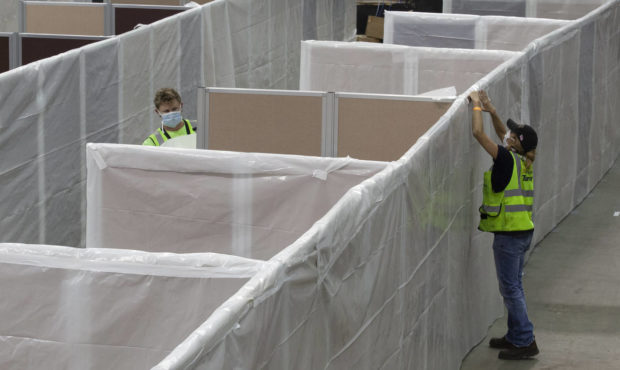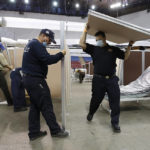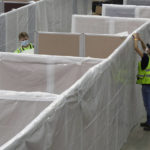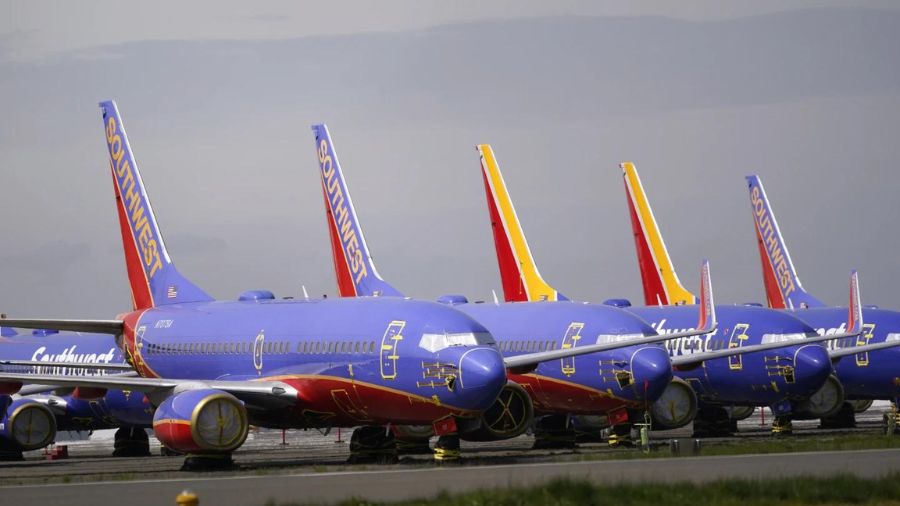California learns costly pandemic lesson about hospitals
Jul 30, 2021, 10:03 PM | Updated: Jul 31, 2021, 12:46 pm

FILE — In this April 18, 2020 file photo sheeting is placed on partitions installed between beds as work is performed to turn the Sleep Train Arena into a 400 bed emergency field hospital to help deal with the coronavirus , in Sacramento, Calif. California spent nearly $200 million to set up, operate and staff alternate care sites that ultimately provided little help when the state’s worst coronavirus surge spiraled out of control last winter, forcing exhausted hospital workers to treat patients in tents and cafeterias. (AP Photo/Rich Pedroncelli, File)
(AP Photo/Rich Pedroncelli, File)
SACRAMENTO, Calif. (AP) — California spent nearly $200 million to set up, operate and staff alternate care sites that ultimately provided little help when the state’s worst coronavirus surge spiraled out of control last winter, forcing exhausted hospital workers to treat patients in tents and cafeterias.
It was a costly way to learn California’s hospital system is far more elastic than was thought at the start of the pandemic. Through desperation and innovation, the system was able to expand enough to accommodate patients even during the dire surge that saw hospitalizations top 20,000 and nearly 700 people die weekly.
“Definitely some hospitals, particularly in the Los Angeles area, were at the breaking point, but we did not see that much use of the alternate care sites relative to what was contemplated,” said Janet Coffman, a health policy professor at University of California, San Francisco. “As dire as the situation was in the winter, it could have been even worse.”
In the early weeks of the pandemic, Democratic Gov. Gavin Newsom ordered alternate care sites be set up in a former professional basketball arena, two state centers that usually treat people with developmental and intellectual disabilities, and other facilities.
It was part of an early plan to add an extra 66,000 hospital beds as California prepared for a projected crushing load of COVID-19 patients, one of many steps taken by the governor as he imposed the nation’s first statewide lockdown.
Ultimately, the state spent $43 million to set up eight sites, $48 million to hire contract employees and $96 million to operate them under a scaled-back plan, according to tallies that The Associated Press requested from the departments of Finance and General Services and the Health and Human Services Agency.
The sites treated a combined 3,582 patients, records show, but half were during the first three months of the pandemic when the number of infections was still low and, as it turned out, the traditional hospital system could have handled them on its own. The sites reopened in early December, treating fewer patients during the next three months even though many hospitals were overflowing.
The traditional hospital system squeaked through the worst of the pandemic with little overflow into the alternate care sites because the state temporarily eased nurse-to-patient staffing ratios — designed to protect the sick and their caretakers — and because of a scramble to bring in temporary outside workers, said Stephanie Roberson, government relations director of the California Nurses Association.
Brian Ferguson, a spokesman for the state Office of Emergency Services, said officials learned that it is better to align the state’s efforts with existing health care facilities than to set up makeshift, standalone hospitals.
For instance, two vacant hospitals reopened during a surge last summer, one each in Northern and Southern California, as the most populous state overtook New York for the most cases in the nation. But it didn’t use them again during the winter surge, choosing instead to work more closely with existing hospitals.
Similarly, Newsom in early April 2020 announced Sleep Train Arena, the former home of the NBA’s Sacramento Kings, would be turned into a 400-bed hospital. It wound up treating just nine patients over 10 weeks because existing hospitals in the region handled other cases.
The state never reopened that main arena when the virus surged again around Thanksgiving but instead treated 232 patients in the much smaller adjacent practice facility.
“If you look in hindsight, you could say, ‘Well, we could have used the money that we spent to rent Sleep Train and we could have put it back into the hospital system or we could have put it into procuring PPE (personal protective equipment) or any number of things,'” Roberson said. “But these are lessons learned.”
She added: “As we move forward, we have to take a look at all of these missteps and do better.”
Officials learned to be more flexible in opening and shutting the facilities and to “quickly pivot the site to have additional value or purpose” if it wasn’t needed for patients, Ferguson said.
For example, the surge centers all shut down by March as the worst infection wave abated. But two were shifted to other pandemic-related duties — one was used for coronavirus testing and the other was used for antibody infusion treatments.
Similarly, contracts for traveling medical workers early in the pandemic required that they work at the alternate care sites even if they were not often needed. But the contracts during the winter surge were rewritten so that “in instances where they were no longer needed, you could quickly move them to a hospital” or to other duties like administering vaccinations, Ferguson said.
State officials had planned to rely more on the newly formed California Health Corps of medical professionals, particularly after 95,000 people initially answered Newsom’s call for volunteers.
But only a fraction actually qualified or signed up.
“When the health corps didn’t pan out as was hoped, travelers were the next best alternative,” said Coffman, who studies the health care workforce. “Yes, contract travelers are expensive, but at least you have confidence this is somebody we can count on to take good care of patients, to have the skills that are needed.”
California spent $612 million for contract medical employees and $2.2 million for the health corps, most of which it hopes to recoup from the federal government or the facilities where they worked.
The state budgeted $74.5 million for the fiscal year that started this month to cover late-arriving bills or if there is another surge that requires the state to ramp up again.
“If things were to take a turn for the worse — mainly delta variant … we still want to be able to move quickly,” said H.D. Palmer, spokesman for the California Department of Finance.
Copyright © The Associated Press. All rights reserved. This material may not be published, broadcast, rewritten or redistributed.














